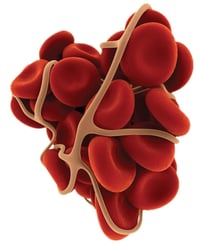

Varicose veins of the lower limbs are dilated subcutaneous veins that are more than 3 mm in diameter and measured in the upright position.[2] Synonyms include varix, varices, and varicosities—all a result of superficial vein incompetence. Active venous ulcers are present in up to 0.5%, and between 0.6% and 1.4% have healed ulcers. On the basis of estimates of the San Diego epidemiologic study, more than 11 million men and 22 million women between the ages of 40 and 80 years in the United States have varicose veins, and more than 2 million adults have advanced CVD with skin changes or ulcers.[1]
Demographics for venous disease
 The biological cause of superficial venous incompetence is likely an intrinsic, morphologic or biochemical abnormality in the vein wall, although the etiology can be multifactorial. One theory is that the origin of venous reflux in patients with primary varicose veins can be local or multifocal structural weakness of the vein wall, and that this can occur together or independently of proximal saphenous vein valvular incompetence.[4] Varicosities can also develop as a result of secondary causes, such as previous deep vein thrombosis (DVT), deep venous obstruction, superficial thrombophlebitis, or arteriovenous fistula. Varicose veins may also be congenital and present as a venous malformation.
The biological cause of superficial venous incompetence is likely an intrinsic, morphologic or biochemical abnormality in the vein wall, although the etiology can be multifactorial. One theory is that the origin of venous reflux in patients with primary varicose veins can be local or multifocal structural weakness of the vein wall, and that this can occur together or independently of proximal saphenous vein valvular incompetence.[4] Varicosities can also develop as a result of secondary causes, such as previous deep vein thrombosis (DVT), deep venous obstruction, superficial thrombophlebitis, or arteriovenous fistula. Varicose veins may also be congenital and present as a venous malformation.Thrombotic risk
The link between varicose veins and thromboembolism risk
The incidence of venous thrombosis in patients with varicose veins has been evaluated. A recent study of a large primary care registry in Germany showed 132 out of 2,357 (5.6%) DVT episodes among patients with VV, compared to 728 out of 80,588 (0.9%) in the patient cohort without VV (p < 0.0001).[7] A study looking at the incidence of SVT in VV aimed to address the role of the programmed cell death in the vein wall by comparing patients with VV with history of SVT to uncomplicated VV. Vein segments from the proximal part of the great saphenous vein (GSV), the distal part of the vein, and from a varicose tributary in 16 patients with varicose vein disease and one patient with SVT, were evaluated for the immunohistochemical expression of pro-apoptotic (Bax, p53, Caspase 3, BCL-6, BCL-xs), anti-apoptotic (BCL-xl and BCL-2) and proliferation (Ki-67) markers. The vein wall in SVT showed increased pro-apoptotic activity compared to uncomplicated disease and normal veins. These results, albeit from a small sample, question whether increased vein wall cell apoptosis is a causative factor for SVT in varicose veins or a repairing mechanism of the thrombosis itself.[10] Therefore, patients with varicose veins may in fact have a hypercoagulable state due to their underlying
The incidence of hypercoagulable states in patients with varicose veins has been evaluated in small studies. A prospective study of 230 patients with VV evaluated the incidence of inherited thrombophilia. A total of 128 patients had an acute episode or a previous history of SVT, while 102 patients did not. Coagulation profile investigation included serum levels of protein C (PC), protein S (PS), anti-thrombin III (AT III),plasminogen (Plg), A2 antiplasmin (A2Apl), and activated protein C resistance (APCR).This was performed at least three months after the SVT episode to ensure that the results were not altered. Obesity, age, and PS deficiency were found as factors associated with SVT in patients with VVs. [11] Another study prospectively followed 97 patients with SVTs and VVs for 55 months, and 13 patients had SVT recurrence— all of which had thrombophilia, most commonly FII mutation. [12]
In patients with VV, an increased risk of DVT was also associated with acquired hypercoagulable states, including previous DVT (adjusted odds ratio (OR): 9.07, 95% confidence interval (CI): 7.78 -10.91), VV (OR 7.33 [CI 6.14 - 8.74]), hospitalization during the last 6 months (OR 1.69 [CI 1.29 - 2.22]), malignancy (OR 1.55 [CI 1.19 - 2.02]), and age (OR 1.02 [CI 1.01 -1.03]. Special attention is required for patients with VV, a history of previous venous thromboembolism, comorbid malignancy, and recent hospital discharge—particularly those with a combination of these factors.[7]
After-evaluation findings for post-treatment thrombotic risk
Based on these findings, the authors recommended DVT prophylaxis in this population.[13] A study from Denmark of 500 consecutive patients (580 legs) with GSV reflux randomized to endovenous laser ablation, radio frequency ablation, foam sclerotherapy, and surgical stripping for great saphenous varicose veins, reported one patient that developed a pulmonary embolus after foam sclerotherapy and one deep vein thrombosis after surgical stripping. No other major complications were recorded.[14)] VTE appears to be rare after vein treatment. Another randomized trial involving 798 participants with primary varicose veins at 11 centers in the United Kingdom compared foam, laser, and surgical varicose vein therapy. The frequency of any procedural complications was lower in the laser group (1.0%) than in the foam group (6.2%) or the surgery group (7.1%) (P<0.001 for both comparisons).
The reported serious adverse events at six months were three DVTs (n= 286 patients, 1.02%) in the foam group, and no thrombosis reported in the other groups.[15] Based on the above reported low risk of VTE after varicose vein treatment, whether to test for thrombophilia in patients with or without history of VTE remains controversial. The American College of Chest Physicians guidelines recommend against the use of prophylaxis in patients with asymptomatic thrombophilia.[16] Since is not likely to change the peri-procedural management, it is likely not warranted to test patients for thrombophilia, regardless of their presentation. The national treatment guidelines vary in their approach to treatment of VV in the setting of hypercoagulable states. The American College of Phlebology clinical practice guidelines on superficial venous disease do not mention hypercoagulable states in their recommendations.[17] The American Venous Forum recommends selective evaluation for hypercoagulable states for those with recurrent DVT, thrombosis at a young age, or thrombosis in an unusual site. They also recommend laboratory examinations in patients with long-standing venous stasis ulcers and in selected patients who undergo general anesthesia for the treatment of chronic venous disease. [18]
Other opinions
If the decision is made to proceed with VV treatment, prophylactic therapy for VTE prevention may be considered. Options include aspirin, low molecular weight heparin(LMWH), warfarin and direct oral anticoagulant medications (DOACS). There is no data to support prophylactic use of ASA after venous procedures in thrombophilic patients, but data from ASPIRE and WARFASA trials evaluating the recurrence of VTE in patients with a history of unprovoked VTE prescribed 100 mg of aspirin showed a statistical significant risk reduction compared to placebo.[20] Prophylactic LMWH has been studied as a preventative measure after procedures in few studies.
A Spanish trial randomly assigned 262 VV patients undergoing treatment who had at least two risk factors (patient, medical, surgical, and hypercoagulable states) to 10 days of prophylactic LMWH—both groups had compression and early ambulation. The patients had visits at 30 days and at three months, and underwent surveillance DVT screening ultrasound at each visit, whether they had symptoms or not. Two patients in the LMWH had known thrombophilia, two in each group had history of VTE, 14 had family history of VTE, and 10 were taking oral contraceptives. No DVTs were found in any group.
Final thoughts
References:
1. Kaplan RM, Criqui MH, Denenberg JO, Bergan J, Fronek A. Quality of life inpatients with chronic venous disease: San Diego population study. Journal ofvascular surgery. 2003;37(5):1047-53.
2. Callam MJ. Epidemiology of varicose veins. The British journal of surgery.1994;81(2):167-73.
3. McLafferty RB, Passman MA, Caprini JA, Rooke TW, Markwell SA, Lohr JM, etal. Increasing awareness about venous disease: The American Venous Forumexpands the National Venous Screening Program. Journal of vascular surgery.2008;48(2):394-9.
4. Labropoulos N, Giannoukas AD, Delis K, Mansour MA, Kang SS, Nicolaides AN,et al. Where does venous reflux start? Journal of vascular surgery. 1997;26(5):736-42.
5. Raju S, Neglen P. Clinical practice. Chronic venous insufficiency and varicoseveins. The New England journal of medicine. 2009;360(22):2319-27.
6. O'Meara S, Cullum N, Nelson EA, Dumville JC. Compression for venous legulcers. The Cochrane database of systematic reviews. 2012;11:CD000265.
7. Muller-Buhl U, Leutgeb R, Engeser P, Achankeng EN, Szecsenyi J, Laux G.Varicose veins are a risk factor for deep venous thrombosis in general practicepatients. VASA Zeitschrift fur Gefasskrankheiten. 2012;41(5):360-5.
8. Lattimer CR, Kalodiki E, Geroulakos G, Syed D, Hoppensteadt D, Fareed J. d-Dimer Levels are Significantly Increased in Blood Taken From Varicose VeinsCompared With Antecubital Blood From the Same Patient. Angiology. 2015.
9. Poredos P, Spirkoska A, Rucigaj T, Fareed J, Jezovnik MK. Do BloodConstituents in Varicose Veins Differ From the Systemic Blood Constituents?European journal of vascular and endovascular surgery : the official journal of theEuropean Society for Vascular Surgery. 2015;50(2):250-6.
10. Filis K, Kavantzas N, Dalainas I, Galyfos G, Karanikola E, Toutouzas K, et al.Evaluation of apoptosis in varicose vein disease complicated by superficial veinthrombosis. VASA Zeitschrift fur Gefasskrankheiten. 2014;43(4):252-9.
11. Karathanos C, Sfyroeras G, Drakou A, Roussas N, Exarchou M, Kyriakou D, etal. Superficial vein thrombosis in patients with varicose veins: role of thrombophiliafactors, age and body mass. European journal of vascular and endovascular surgery :the official journal of the European Society for Vascular Surgery. 2012;43(3):355-8.
12. Karathanos C, Spanos K, Saleptsis V, Tsezou A, Kyriakou D, Giannoukas AD.Recurrence of superficial vein thrombosis in patients with varicose veins.Phlebology / Venous Forum of the Royal Society of Medicine. 2015.
13. Sutton PA, El-Dhuwaib Y, Dyer J, Guy AJ. The incidence of post operativevenous thromboembolism in patients undergoing varicose vein surgery recorded inHospital Episode Statistics. Annals of the Royal College of Surgeons of England.2012;94(7):481-3.
14. Rasmussen LH, Lawaetz M, Bjoern L, Vennits B, Blemings A, Eklof B.Randomized clinical trial comparing endovenous laser ablation, radiofrequency ablation, foam sclerotherapy and surgical stripping for great saphenous varicose veins. The British journal of surgery. 2011;98(8):1079-87.
15. Brittenden J, Cotton SC, Elders A, Ramsay CR, Norrie J, Burr J, et al. Arandomized trial comparing treatments for varicose veins. The New England journalof medicine. 2014;371(13):1218-27.
16. Kearon C, Akl EA, Comerota AJ, Prandoni P, Bounameaux H, Goldhaber SZ, etal. Antithrombotic therapy for VTE disease: Antithrombotic Therapy and Preventionof Thrombosis, 9th ed: American College of Chest Physicians Evidence-BasedClinical Practice Guidelines. Chest. 2012;141(2 Suppl):e419S-94S.
17. Treatment of Superficial Venous Disease of the Lower Leg GuidelinesAmerican College of Phlebology2015 [updated 23 October 2014; cited 2015 7 July2015]. Available from: http://www.phlebology.org/wp-content/uploads/2014/10/SuperficialVenousDiseaseGuidelines.pdf.
18. Gloviczki P, Comerota AJ, Dalsing MC, Eklof BG, Gillespie DL, Gloviczki ML, etal. The care of patients with varicose veins and associated chronic venous diseases:clinical practice guidelines of the Society for Vascular Surgery and the AmericanVenous Forum. Journal of vascular surgery. 2011;53(5 Suppl):2S-48S.
19. Management of chronic venous disorders of the lower limbs - guidelinesaccording to scientific evidence. International angiology : a journal of theInternational Union of Angiology. 2014;33(2):87-208.
20. Simes J, Becattini C, Agnelli G, Eikelboom JW, Kirby AC, Mister R, et al. Aspirinfor the prevention of recurrent venous thromboembolism: the INSPIREcollaboration. Circulation. 2014;130(13):1062-71.
21. San Norberto Garcia EM, Merino B, Taylor JH, Vizcaino I, Vaquero C. Low-molecular-weight heparin for prevention of venous thromboembolism aftervaricose vein surgery in moderate-risk patients: a randomized, controlled trial.Annals of vascular surgery. 2013;27(7):940-6


